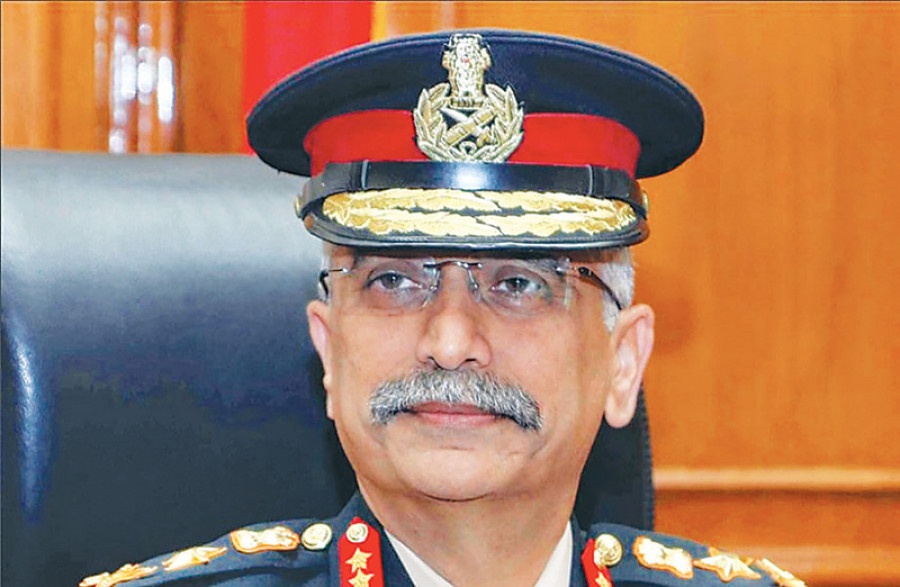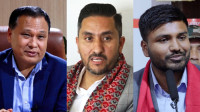National
Observers cautiously optimistic over Indian army chief’s visit
While Naravane may be coming to be conferred the rank of honorary general of Nepal Army, the visit will pave the way for further thaw in relations, officials say.
Anil Giri
Exactly one year after the boundary row erupted between Nepal and India, General Manoj Mukund Naravane, chief of the Indian Army, is arriving on a three-day official visit to Kathmandu on Wednesday.
General Naravane will be the first senior Indian official to visit Nepal after the boundary dispute arose between the two neighbours when India released a new political map incorporating Nepali territories currently occupied by India, last November.
Diplomats and experts have maintained a cautious approach about the visit of Indian army chief who will be conferred the rank of honorary General of the Nepali Army President Bidhya Devi Bhandari on Thursday. Nepal and India have a historic tradition of conferring the honorary title to each other's army chief since 1950.
They believe the success of the visit hinges on how well Prime Minister KP Sharma Oli and Naravane’s counterpart General Purna Chandra Thapa read the mind of the Indian side.
Dinesh Bhattarai, a former ambassador, said Naravane’s visit will not only give Nepal an opportunity to read the Indian mindset but also set the tone for future bilateral engagements, particularly concerning the boundary dispute.
“The visit of Indian army chief gives us an opportunity to read the Indian mind and what they are thinking about advancing the ties. It would be better to understand the Indian position,” Bhattarai told the Post.
The Nepali side should also be heedful not to give the responsibility of resolving the bilateral dispute to the military leadership, according to others.
Bipin Adhikari, who was a member of the task force formed by the government to prepare the position paper on how to deal with boundary issues with India, has strongly opposed the visit of Indian army chief.
“Our government should tell the Indian side to send the political leadership in this context, not the military leadership. At a time when our land is occupied by India, inviting and hosting the Indian army chief is not a good idea. This was a mistake from our side,” said Adhikari.
But those in the Oli administrations have a different view.
Despite having differences over boundary issues, the visit of Indian Army chief shows that our ties with India is heading towards a normal direction, Rajan Bhattarai, foreign relations advisor to Prime Minister KP Sharma Oli, told the Post.
“Though we have some differences, our other engagements with India are very much on track. Other issues like trade, commerce, business, transit and agriculture are on track,” said Bhattarai. “This shows, despite having differences in one issue, our ties with India are moving at a normal pace. Our ties with India have gained maturity. The visit of Indian army chief will create a positive atmosphere to further strengthen our ties,”
The Indian army chief was similarly upbeat in New Delhi.
Speaking to the Indian news agency ANI on Tuesday, ahead of his visit to Nepal, Naravane said that he is delighted to be visiting Nepal on the invitation of his Nepali counterpart General Thapa.
“I am sure that this visit will go a long way in strengthening the bonds and friendships that the two armies cherish,” he told ANI.
Naravane emerged as a divisive figure back in May by suggesting at an online conference that Nepal was protesting the opening of the road by India at Lipulekh at China’s behest.
“I don't know what they are actually agitating about. There is a reason to believe that they might have raised this problem at the behest of someone else and that is very much a possibility,” Naravane had told the conference.
His remarks came after India opened a new track linking the Mansarovar to the Indian state of Uttarakhand via Lipulekh, an area that Nepal claims to be its territory.
Naravane’s remarks had created a huge uproar in Nepal.
Many officials believe that Naravane’s statement was one of the major reasons behind Kathmandu’s decision to release a new map on May 20 incorporating Kalapani, Lipulekh and Limpiyadhura, which are currently occupied by India.
Whether Naravane’s arrival will help defuse the tension between Nepal and India remains to be seen. But officials say both the countries are keen on mending fences.
Officials say that more high-level visits and meetings are scheduled to take place between Nepal and India after Naravane’s visit. But experts and diplomats say it will take more than exchange of visits and meetings to resolve the bitter boundary dispute.
Two government officials privy to the development with ties with India told the Post that after Naravane visit, Foreign Minister Pradeep Gyawali and Foreign Secretary Bharat Raj Poudyal are set to visit India either in a bilateral visit or to participate in the sixth meeting of the Nepal-India Joint Commission to be held at Foreign Minister level.
The meeting is set to take place in New Delhi after both sides agree on a date.
Similarly, Indian Foreign Secretary Harsha Vardhan Shringla is also likely to visit Kathmandu on an introductory visit.
But for now all eyes are on the Indian Army chief, Naravane.
Though Naravane’s visit is expected to help create a positive environment for dialogue between the two countries, there is also the sense of unease about his arrival which comes two weeks after the chief of the Indian intelligence agency, Research and Analysis Wing (R&AW) visited Kathmandu.
Two back-to-back visits by senior Indian security officials have raised suspicion whether the two governments are taking a security-centric approach to resolve the border dispute.
“The visit of R&AW chief and now of the Indian Army chief raises the question whether we are taking a security-centric approach in resolving our dispute? If that’s the case, then it is wrong. We must elevate ties to political and diplomatic level,” said Bhattarai.




 16.2°C Kathmandu
16.2°C Kathmandu







%20(1).jpg&w=300&height=200)






